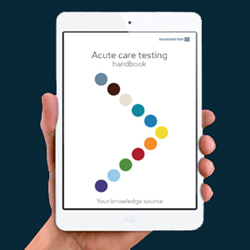
How blood gas analysis supports patient care
Radiometer blood gas analyzers can deliver results on 19 different parameters in just 35 seconds on very small blood samples of only 65 µL.
Better together—blood gas testing to improve patient care
At Radiometer, we have refined our deep knowledge and experience in acute care diagnostics since 1954. We believe that through close collaboration with customers and partners we can focus on improving patient care together.Get in touch to let us know how we can help you with your blood gas analysis.


Videos to support your understanding of blood gas analysis
Radiometer, the market leader in blood gas testing, provides six educational videos to support you in understanding blood gas analysis.
Watch the videos and learn more about blood gas analysis.
Blood gas analysis in three critical patient cases
Case 1:
Click here to renew consent
The COPD patient
(4:45) A Chronic Obstructive Pulmonary Disease (COPD) patient arrives at the emergency department with decreased consciousness and forced respiration. Obviously, immediate action is required, but what is causing the condition?
Case 2: |
Case 3: |
The intoxicated boy(4:19) A 6-year old boy is brought to the emergency department with incoherent speech, forced respiration, decreased level of consciousness and a smell of alcohol on his breath. Is he suffering from a kidney failure or is this a case of intoxication? |
The septic patient(3:51) A 60-year old woman arrives at the emergency department with suspected sepsis. Blood gas analysis shows that she suffers from metabolic acidosis and her x-ray indicates pneumonia. She doesn’t respond to antibiotic treatment. |
How-to videos on blood gas analysis
How to perform an arterial puncture
(4:00) It is important to perform the arterial puncture in the correct way in order to prevent pre-analytical errors that can lead to incorrect results. This video gives you an example of how to perform an arterial puncture correctly.
Understanding the acid-base balance
(5:49) Diseases, intoxication, injuries and other disorders can threaten the acid-base balance in the body. This video explains how the lungs and the kidneys help maintain the pH level in the blood to obtain homeostasis and how the calculation of the Anion Gap can be an important step in identifying the cause of metabolic acidosis.
Reading the blood gas report using Tic-Tac-Toe
(5:00) After measurement of an arterial blood sample on an ABL blood gas analyzer, you receive a patient report. The pH-level, the pCO2 and the concentration of bicarbonate are relevant to determine whether a patient is suffering from respiratory or metabolic acidosis or respiratory or metabolic alkalosis. This video teaches you a clever way to interpret these results using a simple method we call Tic-Tac-Toe.
Related knowledge sources

Scientific articles on blood gas testing
Get the acute care testing handbook
Download the free guide on blood gases and other critical parameters in acute care testing.

Cookies are used on this website
Use of cookiesPlease enter a valid email
We will be sending an e-mail invitation to you shortly to sign in using Microsoft Azure AD.
It seems that your e-mail is not registered with us
Please click "Get started" in the e-mail to complete the registration process
Radiometer is using Microsoft AZURE Active Directory to authenticate users
Radiometer uses Azure AD to provide our customers and partners secure access to documents, resources, and other services on our customer portal.
If your organization is already using Azure AD you can use the same credentials to access Radiometer's customer portal.
Key benefits
- Allow the use of existing Active Directory credentials
- Single-sign on experience
- Use same credentials to access future services
Request access
You will receive an invitation to access our services via e-mail when your request has been approved.
When you accept the invitation, and your organization is already using AZURE AD, you can use the same credentials to access Radiometer's customer portal. Otherwise, a one-time password will be sent via e-mail to sign in.

